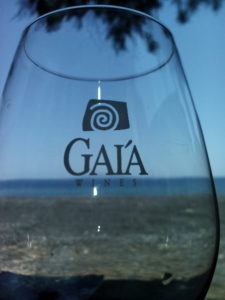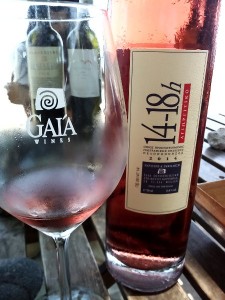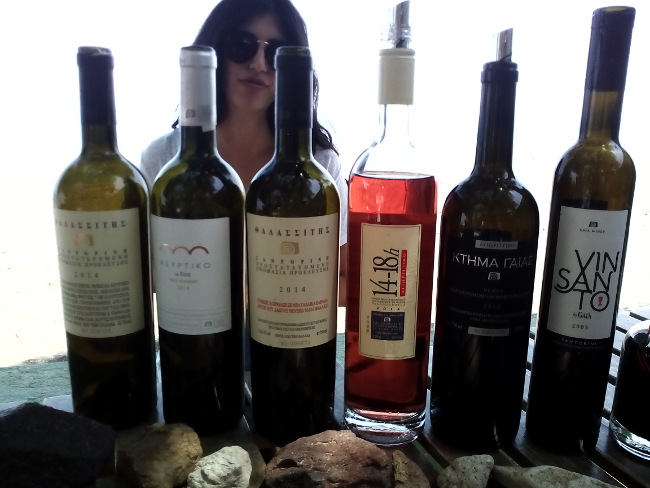What could be better on a holiday than visiting a few wineries, meet people, explore places, and especially taste local wines and traditions. And if we are talking about Greece, on the island of Santorini is a small paradise for wine lovers. Gaia Santorini was the first visited winery, and our host was Maria Papida, with whom I spent an afternoon relaxing on the beach, in the company of best wines that deserve attention.
Established in 1994 by Leon Karatsalos and Yiannis Paraskevopoulos, with a commitment to producing quality wine from the unique indigenous grapes of their native Greece, Gaia winery has several wines that you would ever enjoy with great pleasure.
The influence of microclimate on the island of Santorini give to the wines made here structure and corpulent, mineral and acidity, that blends perfectly with the local cuisine, seafood recalling here, primarily, but also souvlaki, moussaka or greeks appetizers.
The wine cellar is situated on the beach of Kamari and Monolihos resorts, in a location in which functioned until the 1970s, a processing plant cherry tomatoes. After a renovation result charming building, giving it new life as a winery.
And the first wine they produced in 1994 was the AOC Santorini wine, Thalassitis. Their first vintage yielded less than 10,000 bottles, but as its popularity has grown the production of Thalassitis, made from the noble Assyrtiko grape, now exceeds 100,000 bottles a year.
Today, the high-tech equipment and the cutting edge facilities of winery guarantee contemporary winemaking and ideal conditions for high quality production. Thalassitis,  Thalassitis Oak Fermented and Assytiko by Gaia – Wild Ferment are the products of this unique winery, in ex-tomato factory.
Thalassitis Oak Fermented and Assytiko by Gaia – Wild Ferment are the products of this unique winery, in ex-tomato factory.
At the same time, in a discrete out-of-the-way vault, they set up a small oxidization area where produce interesting rare, sweet and aromatic Assyrtiko vinegar, in small quantities (around 1,500 litres).
And now, is time to say a few words about the wines tasted at Gaia!
Thalassitis Santorini 2014 P.D.O. (Dry White)
First one, Thalassitis 2014, made from Assyrtiko grapes, is perhaps the only Mediterranean variety of grape to flourish under such difficult climatic conditions. The vineyard, located on the Southeastern slopes of Episkopi is composed entirely of 70-80 year old, ungrafted vines with a dramatically low yield.
All the Assyrtiko grapes selected for Thalassitis originates exclusively from the vineyards in Episkopi, Akrotiri and Pyrgos regions. The vines are almost 80 years old and have a particularly low-yield that never exceeds 25 hl/ha. Thalassitis is a bone-dry wine with a delicate honeysuckle aroma and a crisp finish, an white wine of a strong personality.
In Antiquity, mixing wine with sea (“Thalassa” in Greek) water was a very well known practice applied to give therapeutic virtues to wine. The wines resulting from this process were called “Thalassitis Oenos” (sea-originated wine). Without mixing, obviously, the wine with seawater, the proximity of Santorini’s vineyard to the Aegean Sea is one of the most important factors forming the special character of Thalassitis.
Thalassitis is produced from Santorini’s indigenous white grape variety, Assyrtiko. It’s a dry white wine, well-structured, nice color (light straw, with a beautifull aromas: honney, springtime flowers, delicate citrus. The taste is full and matur taste is round , full , mature, we find citrus , dominated by a high acidity , a seductive mineral and a long post- taste.
Its mineral dimension will subside while the fruity and honey aromas will expand. For best results, don’t forget to pour Thalassitis into a wide decanter half an hour before serving. Served at 10 degrees, is excellent with seafood, fish, shellfish or even lamb stewed in lemon sauce.
Assyrtiko by Gaia Wild Ferment 2014 Santorini P.D.O. (Dry White)
The Assyrtiko grape from the upland vineyard of Pyrgos is more aromatic than the Assyrtiko from the other parts of Santorini Island. After undergoing the 12-hour skin contact process at around 10C, the grape must is placed in small 1.000 litre inox tanks and in new 225lt French and American oak barrels and acacia barrels.
The temperature is then allowed to rise naturally, without any further involvement. From that point on, modern technology passes the baton to traditional winemaking. Fermentation develops on its own at a gradual pace. The wild yeast strains that prevail are the ones which eventually determine the wine’s character.
Assyrtiko by Gaia Wild Ferment 2014 has delicate and fine citrus aromas well-combined with elegant oak notes, a rich mouth fell, crispy acidity, intense mineral flavours and a long finish. Its mineral dimension will subside while the fruity and honey flavours will envelop its body. With seafood, fatty fish, lamb and poultry is perfect!
Thalassitis Oak Fermented 2014
At this wine could be seen as the meeting point of a traditional Greek wine-grape variety with a typically French wine-making technique.  The Assyrtiko free-run must ferments in 100% new 225 lit French oak casks from the Nevers forest.
The Assyrtiko free-run must ferments in 100% new 225 lit French oak casks from the Nevers forest.
After fermentation, the young wine is aged in these same casks for a 5 to 6 months period during which yeast lees are put frequently into suspension by steering.
The result? Its a beautifully balanced, rich and velvety rond wine, with distinct smoky notes and citrus hints. Full bodied with a lacy and long finish, mineral , full-bodied, explosive in its flavors, impressive.
Is well suited to complicated and adventurous cuisine, far beyond the stereotype white wine-sea food pairing, with an complex character under careful storage for 5-6 years.
14 – 18h Rose 2014 (Peloponnese P.G.I., Dry Rose)
This rose wine produced at the winery in Nemea region (mainland Greece), at an altitude of 800m, are gathered,  crushed and kept in chilled tanks for 14 to 18 hours at 10C. The white must stays in contact with its grape skins developing its rose colour and characteristic aroma of this multifaceted variety.
crushed and kept in chilled tanks for 14 to 18 hours at 10C. The white must stays in contact with its grape skins developing its rose colour and characteristic aroma of this multifaceted variety.
It shows a deep rose color, with fruity aroma, hints of cherry and gooseberry, typical of Agiorgitiko, refreshing flavours characterize the wine.
It’s a summer rose, light, fresh. With greek cuisine (foods, white meat, fish and cold plates) is perfect served at around 8-10 C, in the afthernoon, between 14 – 18 p.m.
Gaia Estate 2012 (Nemea P.D.O., Dry Red)
Gaia is produced from Agiorgitiko grapes cultivated on 7ha vineyard at Koutsi village of Nemea, at an altitude of 550m,give the chance to the ripe Agiorgitiko grape to express its powerful character at full strength. The new wine matures for at least 12 months in new French barriques (225lt) and is bottled without prior treatment such as chilling or filtration in order to preserve the best of all its essential elements.
Gaia Estate 2012 has a deep intense red-black colour, with an complex aromatic profile, that floods the glass revealing a ruby red rim. Expressive on the nose, however it all seems to be hidden behind a huge wall of oak imparted vanilla aromas, revealing dark cherries, plums, blackberries, and violets. However the wine is texturally smooth with great balance between fruit and acidity.
Blackberries and plums on the attack, with same milk chocolate and roasted coffee on the mid-palate, and a spiced finish. With time the oak will integrate and is interesting to discover its real personality.
Vinsanto by Gaia 2005 (sweet)
For “Vinsanto by Gaia”, the primary grape used us Assyrtiko with very small amounts of Athiri and Aidani. The Assyrtiko is hand harvested when ripe but undergoes a variation on the traditional process. This must is then placed in old casks to undergo fermentation which stops once the alcohol level reaches 13% to 14%, giving a atural sweet wine.
The wine is then left to age in the fermentation casks previously used for white wine production for at least 10 years, so it can acquire its deep honey color and complex aromas.  Vinsanto by Gaia is bottled without any fining or filtration. Typical Vinsanto nose, with moderately volatile that contributes to the complexity of the aromas of wine and dried fruits dipped in honey, orange peel and tobacco.
Vinsanto by Gaia is bottled without any fining or filtration. Typical Vinsanto nose, with moderately volatile that contributes to the complexity of the aromas of wine and dried fruits dipped in honey, orange peel and tobacco.
Richly sweet in the mouth, with lively acidity that keeps it in balance and volume in the mouth. Perfumes honeycombs, honey, bitter chocolate and herbal hints in the mouth, with a persistent aftertaste evolving. Enjoy this rare wine at 6-8C with a beautiful dark chocolate dessert. Only some 2.500 bottles of 500ml are produced each vintage.
So, after tasting wines of Gaia, in the shade of some olive trees, its an good experience that you desire to repeat. However, it shows good wines, carefully crafted, many are wines for gastronomy, which make them an interesting experience in itself! Thanks again to Mary Papida for presenting history of Gaia cellar and the wines. We will certainly return with great pleasure! Kalimera!










